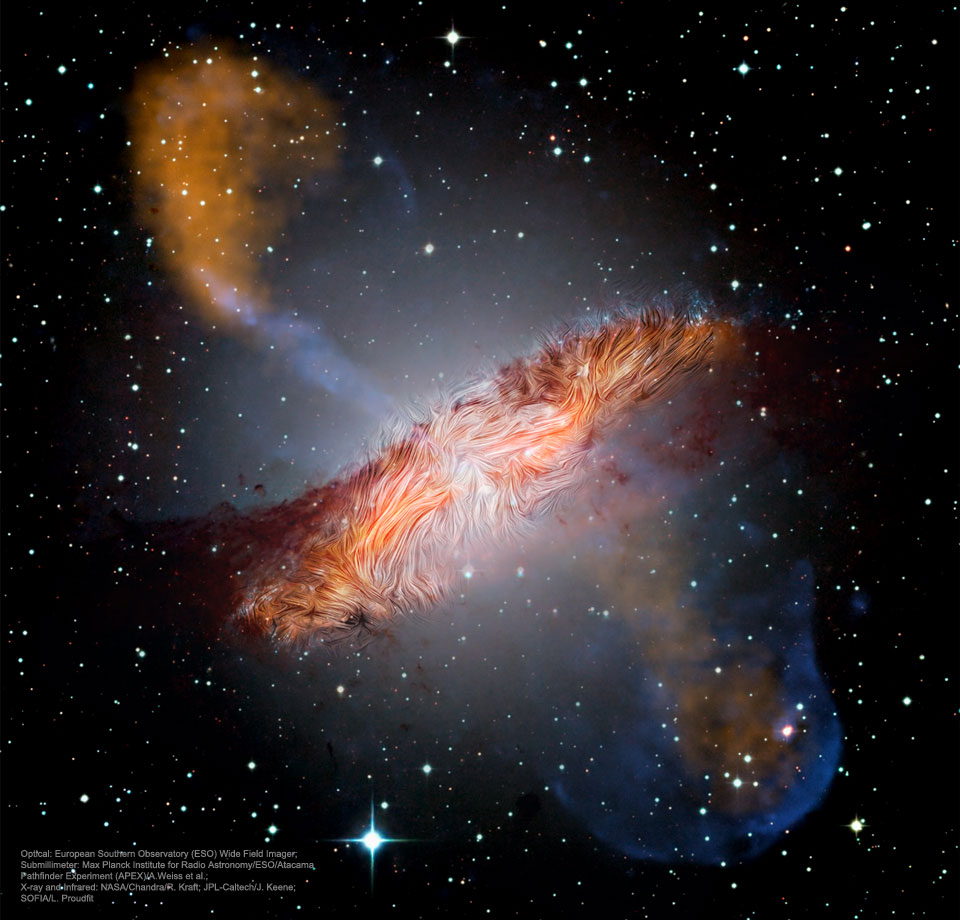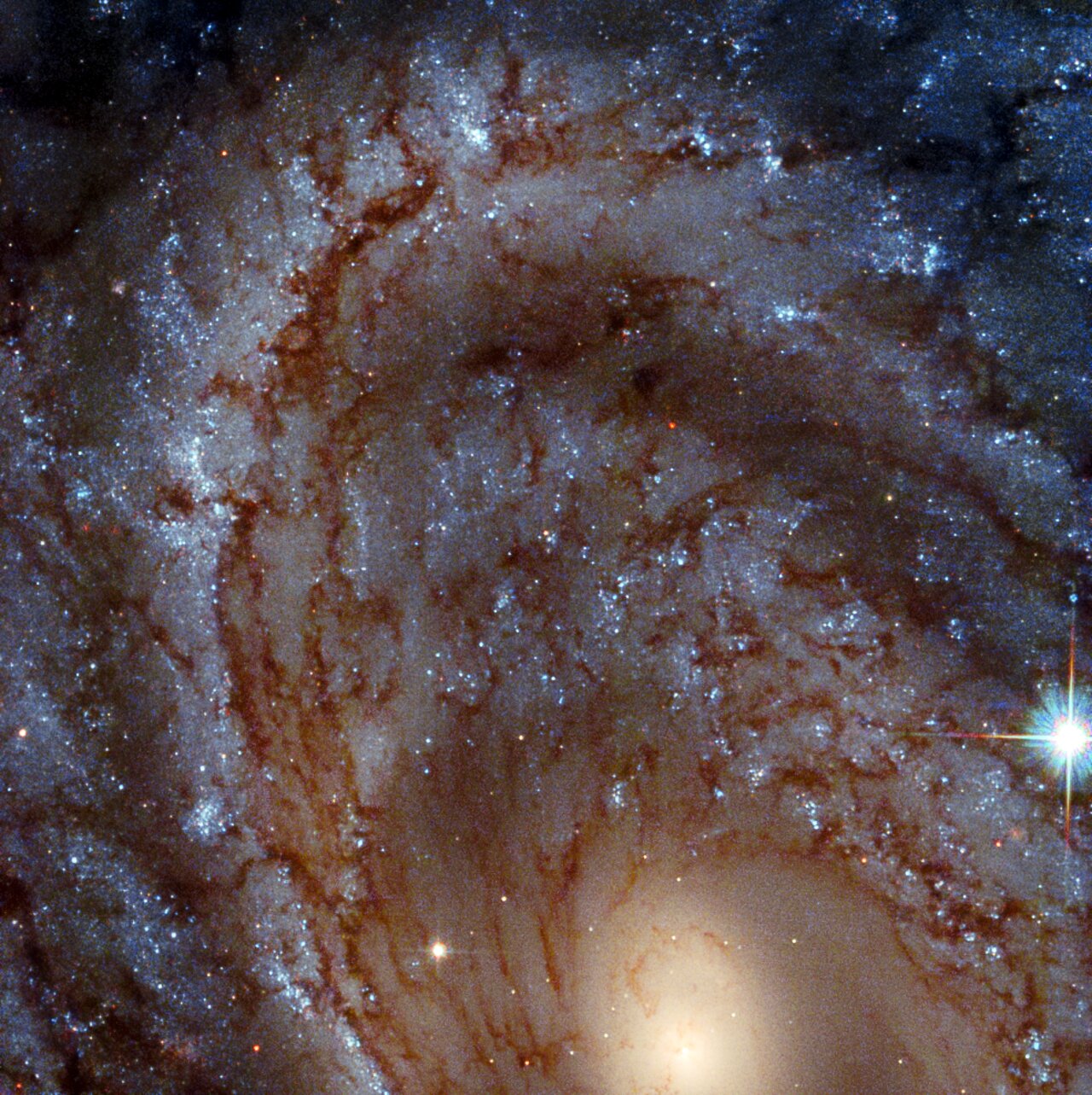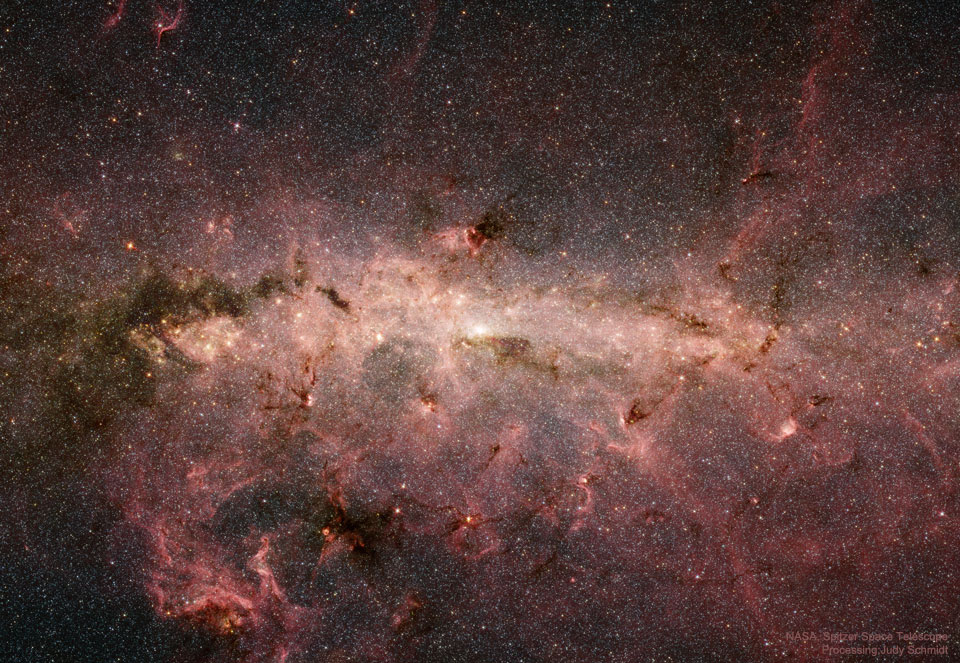Blog
When galaxies collide — what happens to their magnetic fields? To help find out, NASA pointed SOFIA, its flying 747, at galactic neighbor Centaurus A to observe the emission of polarized dust — which traces magnetic fields. Cen A’s unusual shape results from the clash of two galaxies with jets powered by gas accreting onto a central supermassive black hole. In the resulting featured image, SOFIA-derived magnetic streamlines are superposed on ESO (visible: white), APEX (submillimeter: orange), Chandra (X-rays: blue), and Spitzer (infrared: red) images. The magnetic fields were found to be parallel to the dust lanes on the outskirts of the galaxy but distorted near the center. Gravitational forces near the black hole accelerate ions and enhance the magnetic field. In sum, the collision not only combined the galaxies’ masses — but amplified their magnetic fields. These results provide new insights into how magnetic fields evolved in the early universe when mergers were more common.

Michael Franti (born April 21, 1966) is an American rapper, musician, poet, activist, documentarian, and singer-songwriter, known for his participation in many musical projects, most with a political and social emphasis, including the Beatnigs and the Disposable Heroes of Hiphoprisy. He is the creator and lead vocalist of his current independent project, Michael Franti & Spearhead, a band that blends hip hop with a variety of other styles including funk, reggae, jazz, folk, and rock. He is also an outspoken supporter for a wide spectrum of peace and social justice issues, and he is especially an advocate for peace in the Middle East. Michael Franti was born in Oakland, California. His mother, Mary Lofy, had Irish, German, and Belgian ancestry, and his father, Thomas Hopkins, was of African-American and Native American descent. However, his mother put him up for adoption because she was afraid that her racist family would not accept him. He was adopted by Carole Wisti and Charles Franti, a Finnish American couple in Oakland, who at the time had three biological children and one adopted African American son. Charles Franti was a professor in the department of epidemiology and preventive medicine of the UC Davis School of Veterinary Medicine and died in 2003. Michael’s four adoptive siblings are named Rebecca, Sara, Dan, and Matthew. Michael spent his grade 9 school year at Highland Junior High School in Edmonton, Alberta. He then attended Davis Senior High School and University of San Francisco on a full basketball scholarship.
https://www.youtube.com/watch?v=A0fYKguHFcQ
more...
Locksley Wellington “Slide” Hampton (born April 21, 1932) is an American jazz trombonist, composer and arranger. Described by critics as a master composer, arranger and uniquely gifted trombone player, Hampton’s career is among the most distinguished in jazz. As his nickname implies, Hampton’s main instrument is slide trombone, but he also occasionally plays tuba and flugelhorn.
Slide Hampton was born in Jeannette, Pennsylvania. Laura and Clarke “Deacon” Hampton raised 12 children, taught them how to play musical instruments and set out with them as a family band. The family first came to Indianapolis in 1938. The Hamptons were a very musical family in which mother, father, eight brothers, and four sisters, all played instruments. His sisters included Dawn Hampton and Virtue Hampton Whitted. Slide Hampton is one of the few left-handed trombone players. As a child, Hampton was given the trombone set up to play left-handed, or backwards; and as no one ever dissuaded him, he continued to play this way.
At the age of 12, Slide played in his family’s Indianapolis jazz band, The Duke Hampton Band. By 1952, at the age of 20, he was performing at Carnegie Hall with the Lionel Hampton Band. He played with the Buddy Johnson‘s R&B band from 1955–1956, then became a member of Maynard Ferguson‘s band (1957–1959), where he played and arranged, providing excitement on such popular tunes as “The Fugue,” “Three Little Foxes” and “Slides Derangement.” In 1958, he recorded with trombone masters on the classic release of Melba Liston, Melba Liston and Her ‘Bones. As his reputation grew, he soon began working with bands led by Art Blakey, Tadd Dameron in 1969, Barry Harris, Thad Jones, Mel Lewis, and Max Roach, contributing both original compositions and arrangements. In 1962, he formed the Slide Hampton Octet, with horn players Freddie Hubbard, and George Coleman. The band toured the U.S. and Europe and recorded on several labels.
more...James Mundell Lowe (April 21, 1922 – December 2, 2017) was an American jazz guitarist who worked often in radio, television, and film, and as a session musician. He produced film and TV scores in the 1970s, such as the Billy Jack soundtrack and music for Starsky and Hutch, and worked with André Previn‘s Trio in the 1990s. The son of a Baptist minister, Lowe grew up on a farm in Shady Grove, Mississippi, near Laurel. He started playing guitar when he was eight years old, with his father and sister acting as his first teachers. When he was thirteen, he began running away from home to play in bands.Occasionally his father would find him, bring him home, and warn him about the dangers of whiskey. At sixteen, Lowe worked in Nashville on the Grand Ole Opry radio program. He was a member of the Jan Savitt orchestra before serving in the military during World War II.
At basic training, he became friends with John Hammond, who organized weekend jam sessions. He performed in an Army dance band while in Guadalcanal. After his discharge, he called Hammond, looking for work, and Hammond sent him to Ray McKinley. He spent two years with McKinley’s big band in New York City. He joined the Benny Goodman orchestra, then worked intermittently for the next few years at Café Societyand other clubs in New York.
more...This image shows a close-up portrait of the magnificent spiral galaxy NGC 4603, which lies over 100 million light-years away in the constellation of Centaurus (The Centaur). Bright bands of blue young stars make up the arms of this galaxy, which wind lazily outwards from the luminous core. The intricate red-brown filaments threading through the spiral arms are known as dust lanes, and consist of dense clouds of dust which obscure the diffuse starlight from the galaxy. This galaxy is a familiar subject for Hubble. In the last years of the twentieth century, NGC 4063 was keenly and closely watched for signs of a peculiar class of stars known as Cepheid variables. These stars have a luminosity closely tied to the period with which they darken and brighten, allowing astronomers to accurately measure how far they are from Earth. Distance measurements from Cepheid variables are key to measuring the furthest distances in the Universe, and were one of the factors used by Georges Lemaître and Edwin Hubble to show that the Universe is expanding.

Joe Bonner (April 20, 1948 – November 20, 2014) was a hard bop and modal jazz pianist, influenced by McCoy Tyner and Art Tatum.
He was born in Rocky Mount, North Carolina and studied at Virginia State College, but indicated that he learned more about music from musicians he worked with. In the seventies he played with Roy Haynes, Freddie Hubbard, Woody Shaw and Billy Harper, among others.
He died of heart disease in Denver at the age of 66.
more...
Ernesto Antonio “Tito” Puente, Jr. (April 20, 1923 – June 1, 2000) was an American musician, songwriter, record producer and bandleader. The son of Ernest and Felicia Puente, native Puerto Ricans living in New York City’s Spanish Harlem, Puente is often credited as “The Musical Pope”, “El Rey de los Timbales” (The King of the Timbales) and “The King of Latin Music”. He is best known for dance-oriented mambo and Latin jazz compositions that endured over a 50-year career. He and his music appear in many films such as The Mambo Kings and Fernando Trueba‘s Calle 54. He guest-starred on several television shows, including Sesame Street and The Simpsons two-part episode “Who Shot Mr. Burns?“. His most famous song is “Oye Como Va“.
Tito Puente was born on April 20, 1923, at Harlem Hospital Center in the New York borough of Manhattan. His family moved frequently, but he spent the majority of his childhood in the Spanish Harlem area of the city. Puente’s father was the foreman at a razorblade factory.
As a child, he was described as hyperactive, and after neighbors complained of hearing seven-year-old Puente beating on pots and window frames, his mother sent him to 25-cent piano lessons. He switched to percussion by the age of 10, drawing influence from jazz drummer Gene Krupa. He later created a song-and-dance duo with his sister Anna in the 1930s and intended to become a dancer, but an ankle tendon injury prevented him pursuing dance as a career. When the drummer in Machito‘s band was drafted to the army, Puente subsequently took his place.
more...Lionel Leo Hampton (April 20, 1908 – August 31, 2002) was an American jazz vibraphonist, pianist, percussionist, and bandleader. Hampton worked with jazz musicians from Teddy Wilson, Benny Goodman, and Buddy Rich, to Charlie Parker, Charles Mingus, and Quincy Jones. In 1992, he was inducted into the Alabama Jazz Hall of Fame, and he was awarded the National Medal of Arts in 1996.
Lionel Hampton was born in 1908 in Louisville, Kentucky, and was raised by his mother. Shortly after he was born, he and his mother moved to her hometown of Birmingham, Alabama. He spent his early childhood in Kenosha, Wisconsin, before he and his family moved to Chicago, Illinois, in 1916. As a youth, Hampton was a member of the Bud Billiken Club, an alternative to the Boy Scouts of America, which was off-limits because of racial segregation. During the 1920s, while still a teenager, Hampton took xylophone lessons from Jimmy Bertrand and began to play drums. Hampton was raised Roman Catholic, and started out playing fife and drum at the Holy Rosary Academy near Chicago.
more...In visible light, the Milky Way’s center is hidden by clouds of obscuring dust and gas. But in this stunning vista, the Spitzer Space Telescope‘s infrared cameras, penetrate much of the dust revealing the stars of the crowded galactic center region. A mosaic of many smaller snapshots, the detailed, false-color image shows older, cool stars in bluish hues. Red and brown glowing dust clouds are associated with young, hot stars in stellar nurseries. The very center of the Milky Way has recently been found capable of forming newborn stars. The galactic center lies some 26,700 light-years away, toward the constellation Sagittarius. At that distance, this picture spans about 900 light-years.

Cully, Dick (Richard) was born on April 19th, 1949 in Manhattan, New York to his parents, Richard born 1917 and Jeanette born 1921 in New York. In 1955 they moved to Lyndhurst, New Jersey where he began his musical career at the age of 16 studying with James Rago, Julliard School of Music graduate in percussion, timpanist with the Louisville Symphony Orchestra since the early 1970â??s and Professor of Percussion at the University of Louisville. While still in high school, he formed a very popular quartet, (The Charades) with three school friends. The group performed countless club dates and casuals in the New York/New Jersey area. In 1967, he attended the prestigious Berklee College of Music in Boston, studying with drummer Alan Dawson and continued his studies with former Tonight Show drummer Ed Shaughnessy. His early career included performing a variety of musical styles: pop, rock, funk, disco, jazz and country with numerous groups. In 1978 he relocated to Boca Raton, Florida. In 1982, he formed the DICK CULLY BIG BAND, a 15 piece, high energy, exciting unit performing a wide variety of arrangements for all age groups. It features the most popular arrangements from the Libraries of Tommy and Jimmy Dorsey, Glenn Miller, Duke Ellington, Count Basie, Harry James, Buddy Rich, Les Brown , Woody Herman and others as well as the compositions of contemporary artists. Since itâ??s inception, the DICK CULLY BIG BAND has received numerous rave reviews. Has appeared on WLRN-TV Miami, PBS station Channel 17 three times. Black Entertainment Television, Jazz Discovery, NBC Nightly News with Tom Brokaw and WPTV Channel 12, a local CBS affiliate in Palm Beach Florida. The band was also featured weekly on Adelphia Cable with its own 30 minute TV show titled, Strike Up the Band which was also the title of the bands very first album on Ocean Properties Records. It received air play locally in Florida on big band stations as well as the former New York AM radio station, WNEW, once considered to be the premier jazz and big band station in the country. In 1984, he became an artist/endorser for the world famous Slingerland Drum Company, Niles IL and was recognized as a à World Class Drummer by the Pro-Mark Corporation of Houston, Texas, the world’s largest manufacturer of drumsticks.
more...George Bernard Worrell, Jr. (April 19, 1944 – June 24, 2016) was an American keyboardist and record producer best known as a founding member of Parliament-Funkadelic and for his work with Talking Heads. He is a member of the Rock and Roll Hall of Fame, inducted in 1997 with fifteen other members of Parliament-Funkadelic. Worrell was described by Jon Pareles of The New York Times as “the kind of sideman who is as influential as some bandleaders.”
Worrell was born in Long Branch, New Jersey, and grew up in Plainfield, New Jersey, where his family moved when he was eight. A musical prodigy, he began formal piano lessons by age three and wrote a concerto at age eight. He went on to study at the Juilliard School and received a degree from the New England Conservatory of Music in 1967. As a college student, Worrell played with a group called Chubby & The Turnpikes; this ensemble eventually evolved into Tavares.
https://www.youtube.com/watch?v=gRDzjBAR3ww
more...Alexis Andrew Nicholas Koerner (19 April 1928 – 1 January 1984), known professionally as Alexis Korner, was a British blues musician and radio broadcaster, who has sometimes been referred to as “a founding father of British blues“. A major influence on the sound of the British music scene in the 1960s, Korner was instrumental in the formation of several notable British bands including The Rolling Stones and Free.
Alexis Andrew Nicholas Koerner was born on 19 April 1928 in Paris, France, to an Austrian Jewish father and a mother of Greek, Turkish and Austrian descent. He spent his childhood in France, Switzerland and North Africa and arrived in London in 1940 at the start of World War II. One memory of his youth was listening to a record by black pianist Jimmy Yancey during a German air raid. Korner said, “From then on all I wanted to do was play the blues.
more...Thomas Benford (April 19, 1905 – March 24, 1994) was an American jazz drummer. Tommy Benford was born in Charleston, West Virginia. He and his older brother, tuba player Bill Benford, were both orphans who studied music at the Jenkins Orphanage in Charleston, South Carolina. He went on tour with the school band, traveling with them to England in 1914.
In 1920, he was working with the Green River Minstrel Show. Benford recorded with Jelly Roll Morton[5] in 1928 and 1930. He also played with Duke Ellington, Fats Waller and Eddie South. From 1932 till 1941 Benford lived in Europe, where in 1937 he participated in one of the most memorable recording sessions ever in Paris, with Coleman Hawkins, Benny Carter, Django Reinhardt and Stéphane Grappelli.
Benford died on March 24, 1994, at Mount Vernon Hospital in Mount Vernon, New York.
more...More Posts
- Temple Israel
- Cosmo NGC 2244
- Tete Montoliu
- Thad Jones
- Flamenco Fridays Camerón
- Daily Roots Sly and The Revolutionaries
- MAGA Science
- Jeffery Goldberg Truth
- Sieg Heil
- Cosmo M81
- Junior Parker
- Leroy Carr
- Sarah Vaughan
- Victor Bailey
- Ben Webster
- World Music Emilio Villalba
- Daily Roots-Roots Radics
- Child Labor Protections Repeal
- Walz Courage
- Texting 101